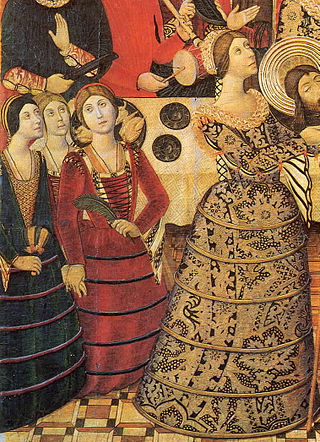
A farthingale is one of several structures used under Western European women's clothing - especially in the 16th and 17th centuries - to support the skirts in the desired shape and to enlarge the lower half of the body. The fashion originated in Spain in the fifteenth century. Farthingales served important social and cultural functions for women in Renaissance Europe as they expressed, primarily when worn by court women, high social position and wealth.

The French hood is a type of woman's headgear that was popular in Western Europe in the 16th century.

Mary Scudamore was a courtier to Elizabeth I.
Costume and gold and silver plate belonging to Elizabeth I were recorded in several inventories, and other documents including rolls of New Year's Day gifts. Arthur Jefferies Collins published the Jewels and Plate of Queen Elizabeth I: The Inventory of 1574 from manuscripts in 1955. The published inventory describes jewels and silver-plate belonging to Elizabeth with detailed references to other source material. Two inventories of Elizabeth's costume and some of her jewellery were published by Janet Arnold in Queen Elizabeth's Wardrobe Unlocke'd.

A partlet was a 16th-century fashion accessory. The partlet was a sleeveless garment worn over the neck and shoulders, either worn over a dress or worn to fill in a low neckline.
Lady Audrey Walsingham was an English courtier. She served as Lady of the Bedchamber to queen Elizabeth I of England, and then as Mistress of the Robes to Anne of Denmark from 1603 until 1619.
Dorothy Speckard or Speckart or Spekarde was a courtier, milliner, silkwoman, and worker in the wardrobe of Elizabeth I of England, Anne of Denmark, Prince Henry, and Henrietta Maria. Her husband, Abraham Speckard, was an investor in the Somers Isles Company which colonised Bermuda.
Mary Radcliffe or Ratcliffe (1550-1617) was a courtier of Queen Elizabeth I of England.
Giovanni Carlo Scaramelli (1550-1608) was a Venetian diplomat based in London at the end of the reign of Elizabeth I and the beginning of the reign of James VI and I.

Eleanor or Alianor Verney was an English courtier who travelled to Scotland with Margaret Tudor in 1503.
Mary Finch or Fynche (1508-1557) was an English courtier of Mary I of England.

An inventory of the jewels of Mary I of England, known as Princess Mary or the Lady Mary in the years 1542 to 1546, was kept by her lady in waiting Mary Finch. The manuscript is now held by the British Library. It was published by Frederic Madden in 1831. Some pieces are listed twice. Two surviving drawings feature a ribbon with the inscription, "MI LADI PRINSIS". The British Library also has an inventory of the jewels she inherited on coming to the throne in 1553.
Roger Ratcliffe was an English courtier.

William Cookesbury or Coksbery, or Cookisbury was a London capper, haberdasher, and supplier of feathers.
A silkwoman was a woman in medieval, Tudor, and Stuart England who traded in silks and other fine fabrics. London silkwomen held some trading rights independently from their husbands and were exempted from some of the usual customs and laws of coverture. The trade and craft of the silkwoman was encouraged by a statute of Henry VI of England as a countermeasure to imports of silk thread, and a suitable occupation for "young gentlewomen and other apprentices".

The coronation of Mary I as Queen of England and Ireland took place at Westminster Abbey, London, on Sunday 1 October 1553. This was the first coronation of a queen regnant in England, a female ruler in her own right. The ceremony was therefore transformed. Ritual and costume were interlinked. Contemporary records insist the proceedings were performed "according to the precedents", but mostly these were provisions made previously for queens consort.
George Brediman or Bredyman was an English courtier serving Mary I of England and Elizabeth I. Brediman was a groom of the privy chamber and keeper of the privy purse. His wife, Edith Brediman, was a chamberer at court.

Walter Fyshe was a London tailor who worked for Elizabeth I until 1582. He also made some of her farthingales. Fyshe made the queen's ceremonial clothes and coronation robes, altering robes made for the coronation of Mary I of England.
Mother of the Maids was a position at the English royal court. The Mother of the Maids was responsible for the well-being and decorum of maids of honour, young gentlewomen in the household of a queen regnant or queen consort.

A safeguard or saveguard was a riding garment or overskirt worn by women in the sixteenth and seventeenth centuries. Some safeguards were intended to protect skirts or kirtles worn beneath. Mary Frith, dramatised as the character Moll Cutpurse in The Roaring Girl, wore a black safeguard over breeches.










